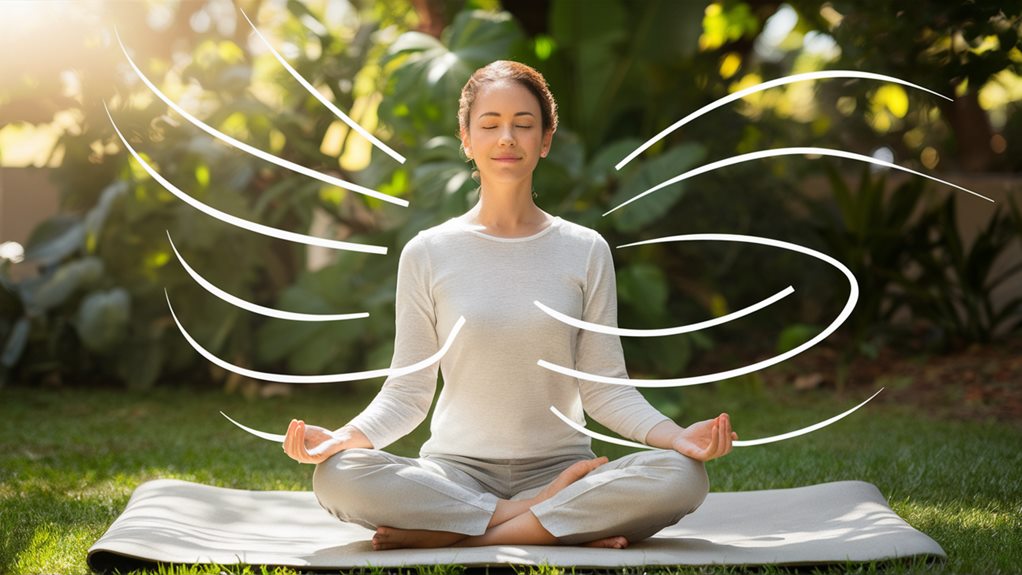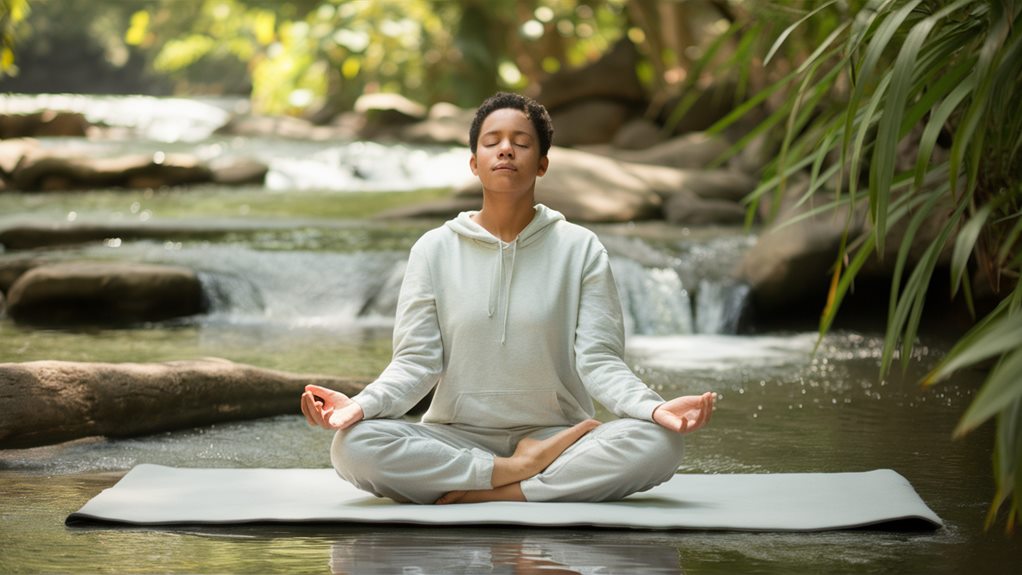You can elevate your meditation practice by incorporating three simple breathing techniques. First, try diaphragmatic breathing; it encourages complete lung expansion and grounds you in the present moment. Next, practice box breathing: inhale for four counts, hold for four, exhale for four, and hold again for four. This method calms your mind and enhances focus. Finally, the 4-7-8 breathing technique promotes a deep sense of calm. Inhale for four counts, hold for seven, then exhale for eight. This structured approach enhances breath awareness, helping you stay present. Keep exploring to discover more ways to deepen your practice.
Key Takeaways
- Diaphragmatic breathing promotes full lung expansion, grounding you in the present moment for enhanced mindfulness during meditation.
- Box breathing provides structure, enhancing focus and calming the mind while encouraging muscle relaxation.
- 4-7-8 breathing fosters calm and clarity, improving your ability to remain present and creating a soothing environment.
- Practicing breath awareness activates the relaxation response, helping release tension and quiet the mind for clearer focus.
- Regularly incorporating these techniques can shift overall well-being, guiding you toward deeper relaxation and a more tranquil meditation experience.
Diaphragmatic Breathing

Diaphragmatic breathing, often regarded as the cornerstone of effective meditation, invites you to reconnect with your breath and cultivate a sense of inner peace. This technique encourages you to use your diaphragm fully, allowing your lungs to expand completely. As you breathe in deeply, feel your abdomen rise. When you exhale, let your belly fall naturally. This simple act not only grounds you in the present moment but also enhances your mindfulness benefits, as you can track your progress through tools like a Mindfulness Journal to document your experiences.
When you practice diaphragmatic breathing, you activate your body's relaxation response. It's one of the most powerful relaxation techniques available, helping to reduce stress and anxiety. Each inhale draws in calming energy, while each exhale releases tension and worries. You'll find that your mind quiets, allowing you to focus more clearly on your meditation practice.
To begin, find a comfortable position, either sitting or lying down. Close your eyes and place one hand on your chest and the other on your belly. As you breathe, notice how your belly rises and falls more than your chest. Aim for a slow, rhythmic pattern—perhaps inhaling for a count of four, holding for a count of four, and exhaling for a count of six.
With regular practice, you'll notice a shift in your overall well-being. This connection to your breath can create a sense of belonging within yourself, fostering peace in your hectic life. Embrace this technique, and let it guide you toward deeper relaxation and mindfulness.
Box Breathing

Many find that box breathing is a powerful technique to enhance focus and calm the mind during meditation. This structured breathing method helps you cultivate mindfulness and provides a sense of belonging in your practice. To get started, you'll want to find a comfortable seated position, allowing your body to relax. Engaging in focused breathing can also complement physical recovery methods, such as using a massage gun, which promotes muscle relaxation and reduces tension.
Begin by inhaling deeply through your nose for a count of four. As you breathe in, visualize filling your lungs completely. Hold that breath for another count of four, feeling the stillness and control this brings.
Next, exhale slowly through your mouth for a count of four, letting go of any tension or distractions. Finally, pause for another count of four before taking your next breath. This creates a "box," with each side representing the same duration of breath.
By repeating this cycle several times, you engage in a profound mindfulness practice. Box breathing not only promotes relaxation but also helps you develop clarity, as it anchors your thoughts and emotions.
You may find that with each cycle, your mind quiets, and your heart rate slows, bringing you deeper into a meditative state.
As you incorporate box breathing into your routine, remember that it's a valuable tool among relaxation techniques. With practice, you'll discover how easily this method can ground you, allowing you to connect more fully with yourself and those around you.
Embrace this technique, and let it guide you towards a more peaceful, focused meditation experience.
4-7-8 Breathing

Incorporating -8 breathing into your meditation practice can greatly enhance your sense of calm and clarity. This technique emphasizes breath awareness, allowing you to tap into a deeper state of mindfulness, much like the supportive environment created by a well-chosen meditation cushion set 5 Best Meditation Cushion Sets. By focusing on your breath, you draw your attention away from distractions, creating a soothing environment for your mind and body.
To practice -8 breathing, follow these simple steps:
- Inhale for 4 counts: Take a slow, deep breath in through your nose, filling your lungs completely. Focus on the sensation of air entering your body.
- Hold for 8 counts: Gently hold your breath, allowing the stillness to envelop you. Use this time to cultivate a mindful focus, reflecting on the present moment.
- Exhale for 4 counts: Release your breath slowly through your mouth, feeling the tension leave your body. With each exhale, visualize any stress melting away.
As you integrate -8 breathing into your meditation, you'll find that it enhances your ability to remain present. This rhythmic pattern helps ground you, fostering a sense of belonging within yourself and the world around you.
You'll not only develop greater breath awareness but also create a serene space for personal growth. Remember, the key is consistency; over time, you'll notice profound shifts in your meditation practice, allowing you to embrace each moment with a tranquil heart and a focused mind. Enjoy the journey!
Frequently Asked Questions
Can Breathing Techniques Replace Traditional Meditation Practices Entirely?
Breathing techniques can offer significant benefits, like reducing stress and enhancing focus, but they shouldn't entirely replace traditional meditation practices.
While breathwork can be a powerful tool, it lacks the depth of introspection and mindfulness developed through meditation. Each has its drawbacks; breathwork may feel too structured for some, while meditation can be challenging to maintain.
Embracing both can create a richer, more fulfilling experience, fostering a sense of belonging within your practice.
How Long Should I Practice These Breathing Methods Daily?
You should aim for at least 10 to 15 minutes of daily commitment to your breathing methods. This duration can help you experience the benefits of reduced stress and increased focus.
Consistency is key; try to incorporate these techniques into your routine, ideally at the same time each day. As you progress, you might want to extend your practice, allowing deeper connection and grounding in your daily life.
Are There Any Risks Associated With These Breathing Techniques?
Yes, there can be potential side effects when practicing breathing techniques. You might experience lightheadedness, anxiety, or discomfort if you push yourself too hard or breathe too rapidly. It's crucial to listen to your body and adjust accordingly.
If you find these techniques overwhelming, consider alternative techniques like gentle yoga or mindfulness exercises. Remember, meditation is about finding peace, so prioritize what feels right for you and your journey.
Can I Use These Methods Outside of Meditation Sessions?
Absolutely, you can use these breathing methods anytime, like having a magic wand for daily mindfulness! Integrating them into your routine can transform ordinary moments into opportunities for stress management.
Whenever you feel overwhelmed or need a moment of calm, just pause and focus on your breath. You'll find that these techniques not only enhance meditation but also foster a sense of belonging and connection to the present moment throughout your day.
What Should I Do if I Feel Lightheaded While Practicing?
If you feel lightheaded while practicing, it's important to manage dizziness calmly.
First, pause and take a moment to breathe deeply, grounding yourself. You might want to sit down to regain your balance.
If the sensation persists, seeking guidance from a teacher or a healthcare professional can offer reassurance.
Remember, it's okay to acknowledge your body's needs and adjust your practice accordingly.
You're not alone in this journey—many share similar experiences.
Conclusion
Incorporating these breathing techniques into your meditation practice can transform your experience, much like finding the eye of a storm amidst chaos. By mastering diaphragmatic breathing, box breathing, and the 4-7-8 method, you'll cultivate a deeper sense of calm and clarity. Remember, each breath is a step towards serenity, guiding you to a more mindful existence. Embrace these practices, and watch as your inner landscape flourishes, revealing the peace that lies within.

